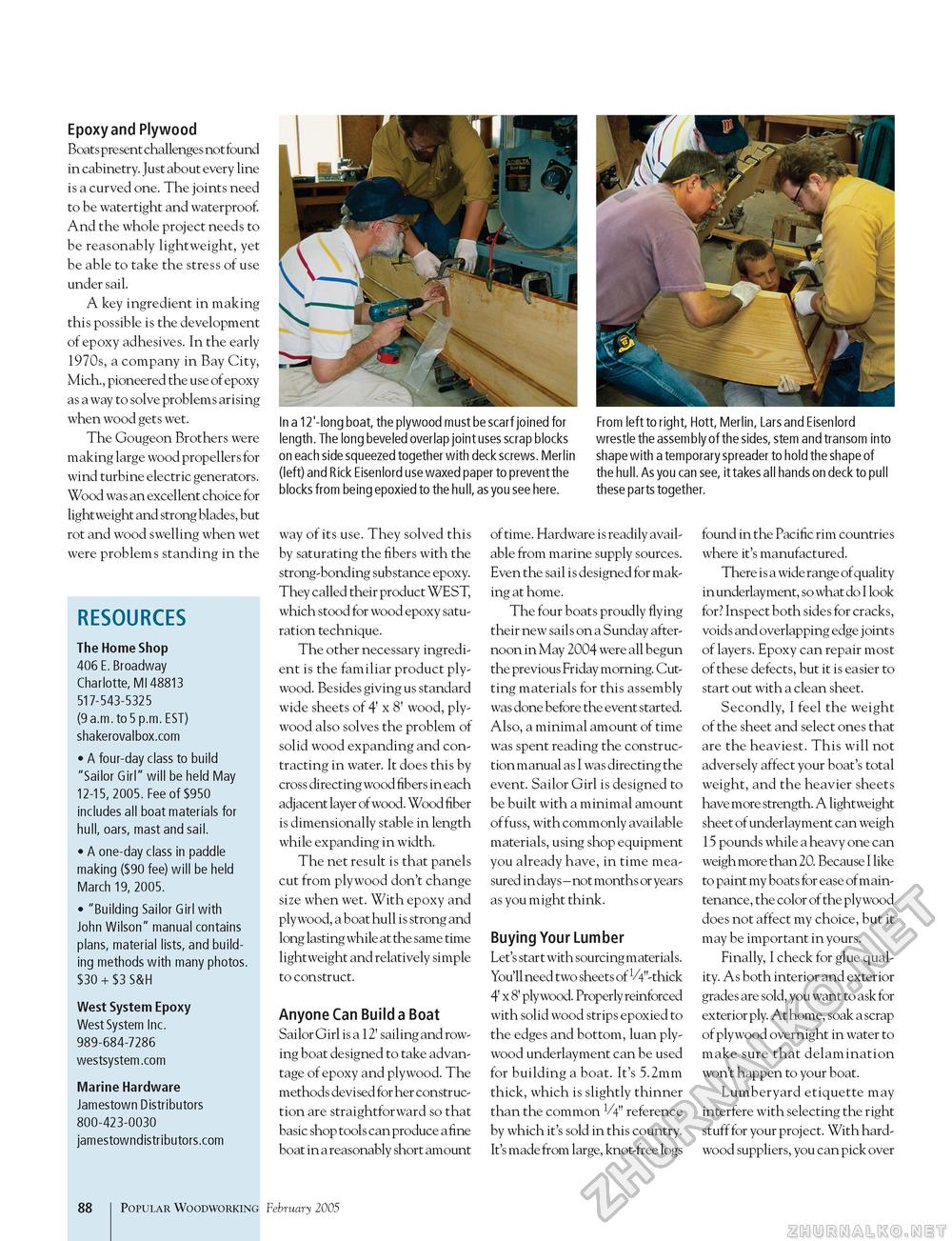Popular Woodworking 2005-02 № 146, страница 93
In a 12'-long boat, the plywood must be scarf joined for length. The long beveled overlap joint uses scrap blocks on each side squeezed together with deck screws. Merlin (left) and Rick Eisenlord use waxed paper to prevent the blocks from being epoxied to the hull, as you see here. From left to right, Hott, Merlin, Lars and Eisenlord wrestle the assembly of the sides, stem and transom into shape with a temporary spreader to hold the shape of the hull. As you can see, it takes all hands on deck to pull these parts together. Epoxy and Plywood Boats present challenges not found in cabinetry. Just about every line is a curved one. The joints need to be watertight and waterproof. And the whole project needs to be reasonably lightweight, yet be able to take the stress of use under sail. A key ingredient in making this possible is the development of epoxy adhesives. In the early 1970s, a company in Bay City, Mich., pioneered the use of epoxy as a way to solve problems arising when wood gets wet. The Gougeon Brothers were making large wood propellers for wind turbine electric generators. Wood was an excellent choice for lightweight and strong blades, but rot and wood swelling when wet were problems standing in the RESOURCES The Home Shop 406 E. Broadway Charlotte, MI 48813 517-543-5325 (9 a.m. to 5 p.m. EST) shakerovalbox.com • A four-day class to build "Sailor Girl" will be held May 12-15, 2005. Fee of $950 includes all boat materials for hull, oars, mast and sail. • A one-day class in paddle making ($90 fee) will be held March 19, 2005. • "Building Sailor Girl with John Wilson" manual contains plans, material lists, and building methods with many photos. $30 + $3 S&H West System Epoxy West System Inc. 989-684-7286 westsystem.com Marine Hardware Jamestown Distributors 800-423-0030 jamestowndistributors.com way of its use. They solved this by saturating the fibers with the strong-bonding substance epoxy. They called their product WEST, which stood for wood epoxy saturation technique. The other necessary ingredient is the familiar product plywood. Besides giving us standard wide sheets of 4' x 8' wood, plywood also solves the problem of solid wood expanding and contracting in water. It does this by cross directing wood fibers in each adjacent layer of wood. Wood fiber is dimensionally stable in length while expanding in width. The net result is that panels cut from plywood don't change size when wet. With epoxy and plywood, a boat hull is strong and long lasting while at the same time lightweight and relatively simple to construct. Anyone Can Build a Boat Sailor Girl is a 12' sailing and rowing boat designed to take advantage of epoxy and plywood. The methods devised for her construction are straightforward so that basic shop tools can produce a fine boat in a reasonably short amount of time. Hardware is readily available from marine supply sources. Even the sail is designed for making at home. The four boats proudly flying their new sails on a Sunday afternoon in May 2004 were all begun the previous Friday morning. Cutting materials for this assembly was done before the event started. Also, a minimal amount of time was spent reading the construction manual as I was directing the event. Sailor Girl is designed to be built with a minimal amount of fuss, with commonly available materials, using shop equipment you already have, in time measured in days - not months or years as you might think. Buying Your Lumber Let's start with sourcing materials. You'll need two sheets of v"-thick 4' x 8' plywood. Properly reinforced with solid wood strips epoxied to the edges and bottom, luan plywood underlayment can be used for building a boat. It's 5.2mm thick, which is slightly thinner than the common V4" reference by which it's sold in this country. It's made from large, knot-free logs found in the Pacific rim countries where it's manufactured. There is a wide range of quality in underlayment, so what do I look for? Inspect both sides for cracks, voids and overlapping edge joints of layers. Epoxy can repair most of these defects, but it is easier to start out with a clean sheet. Secondly, I feel the weight of the sheet and select ones that are the heaviest. This will not adversely affect your boat's total weight, and the heavier sheets have more strength. A lightweight sheet of underlayment can weigh 15 pounds while a heavy one can weigh more than 20. Because I like to paint my boats for ease of maintenance, the color of the plywood does not affect my choice, but it may be important in yours. Finally, I check for glue quality. As both interior and exterior grades are sold, you want to ask for exterior ply. At home, soak a scrap of plywood overnight in water to make sure that delamination won't happen to your boat. Lumberyard etiquette may interfere with selecting the right stuff for your project. With hardwood suppliers, you can pick over 88 Popular Woodworking February 2005 |








